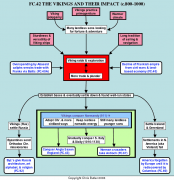FC42: The Vikings and their impact (c.800-1000 CE)
Flowchart
FC42 in the
Hyperflow of History.
Covered in multimedia lecture #6716.
For nearly two centuries there was hardly a church in northern Europe that did not echo with the prayer: "Deliver us O Lord from the wrath of the Northmen". While other peoples, notably the Arabs from the south and the nomadic Magyars (Hungarians) from the east, also raided and plundered Europe, it was the Vikings who wreaked the most havoc in the short run, but probably had the most positive long term effects on Europe.
Various forces launched the Vikings in their raids and voyages of exploration. Two of these factors we have already seen: the decline of the Frankish Empire after Charlemagne's death which invited raids, and the overspending by the Arab caliphs which wrecked trade in the Baltic Sea and forced the Vikings to seek their fortunes through more violent means. Another factor was a growing population of landless younger sons looking for fortune and adventure caused by a good climate (allowing more children to survive), and the Viking customs of polygamy (having more than one wife) and primogeniture (leaving the entire inheritance to the oldest son).
Two other remarkable factors were the Vikings' ships and their navigation techniques. There were various classes of Viking ships ranging from the typical longship and the larger dragonships ( drakkar) to the stouter oceangoing hafskips (half ships). However, they shared certain common characteristics that made them quite versatile. They could hold up to 200 men in some cases, yet be sailed by as few as 15 sailors. They were strong enough to handle rough seas, but were also light enough to sail up inland rivers and even be carried around river defenses. Likewise, Viking navigation techniques, which were basically the product of a centuries' long oral tradition of sailors' lore, got them safely across open waters that other peoples of the time would never dream of sailing. In our eyes, the Vikings were remarkable and fearless sailors. In the eyes of many of their contemporaries, they were downright mad for making the voyages they did, which only added to their mystique.
Starting around 800 A.D., wave after wave of Vikings set out from Scandinavia either to raid their neighbors or explore new and more distant lands for the purpose of trading and settling there. Viking raids created a feedback cycle by weakening their victims while also winning plunder and status, which encouraged more and larger raids, and so on. As raiding parties increased in size, the Vikings would grow bolder and strike further inland by sailing up inland rivers or even seizing local horses to carry them and their plunder. As repeated successes further increased the size of the raiding parties, the Vikings would establish winter bases rather than return home to Scandinavia for the winter. Eventually these winter bases might become permanent settlements and the basis for the eventual conquest of the region.
Viking raids and conquests were accompanied by a good number of atrocities that reflected the Vikings' rough character, but were also designed to intimidate their victims. The Vikings showed no special respect for Christian churches and monasteries. In fact, those were generally their first targets, since the Church owned so much of the wealth in Western Europe at the time. However, the Vikings were also great traders, not seeing trade and plunder as mutually exclusive, and combining these activities according to what the situation dictated or allowed. As a result, they opened up trade routes, which helped start a revival of Europe's economy.
Ironically, considering all the chaos and destruction the Vikings brought with them, they founded some of the best-organized and most dynamic states in Western Europe. In 911 A.D. they founded Normandy as a virtually independent state in western France. Having established a well-run government there, they spread out to conquer England in 1066, laying the foundations for that modern nation. They also gradually conquered Southern Italy and Sicily in the eleventh and twelfth centuries and set up strong state there just as they had in Normandy and England. Some of these Normans later joined the First Crusade and conquered Antioch in Syria, holding it for nearly two centuries.
Other Vikings (known as the Rus) struck eastward and founded the first Russian state centered around Kiev. From there, they raided the Byzantine Empire. Later, Byzantine missionaries followed them back to Russia, bringing with them Christianity, Byzantine architecture and the Cyrillic alphabet, all of which became vital elements of Russian culture.
The Vikings were also fearless explorers. To the west, they founded a state in Iceland, continued across the Atlantic and discovered Greenland and North America. However, Greenland's climate proved to be too harsh to support even the Vikings, while attacks by Native Americans called "Skraelings" (screechers) made settlements there also short-lived. However, the rest of Europe was not ready to absorb these new discoveries, and they were forgotten for nearly 500 years.


